
Concept explainers
(a)
Interpretation:
The structure of the compound having molecular formula,
Concept introduction:
Many nuclei and electrons have spin. Due to this spin magnetic moment arises. The energy of this magnetic moment depends on the orientation of the applied magnetic field. In NMR spectroscopy, every nucleus has a spin. There is an
Answer to Problem 13.40AP
The structure of the compound having molecular formula,
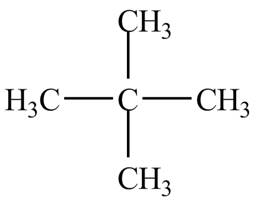
Explanation of Solution
There is only one signal in the compound that means all the protons are equivalent and all the protons are from methyl group as per chemical shift value of
Therefore, the structure of the compound corresponding to NMR data is shown below.
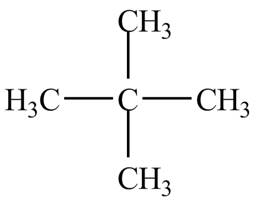
Figure 1
The structure of the compound having molecular formula,
(b)
Interpretation:
The structure of the compound having molecular formula
Concept introduction:
Many nuclei and electrons have spin. Due to this spin magnetic moment arises. The energy of this magnetic moment depends on the orientation of the applied magnetic field. In NMR spectroscopy, every nucleus has a spin. There is an angular momentum related to the spin. The difference between its resonance frequency and that of the reference standard is known as the chemical shift of a nucleus. Tetramethylsilane (TMS) is taken as reference.
Answer to Problem 13.40AP
The structure of the compound having molecular formula
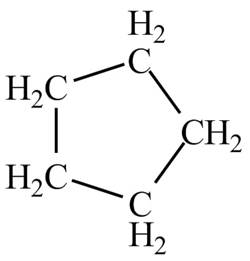
Explanation of Solution
There is only one signal in the compound that means all the protons are equivalent and all the protons are from methylene group as per chemical shift value of
Therefore, the structure of the compound corresponding to NMR data is shown below.
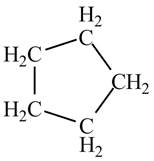
Figure 2
The structure of the compound having molecular formula
(c)
Interpretation:
The structure of the compound having molecular formula
Concept introduction:
Many nuclei and electrons have spin. Due to this spin magnetic moment arises. The energy of this magnetic moment depends on the orientation of the applied magnetic field. In NMR spectroscopy, every nucleus has a spin. There is an angular momentum related to the spin. The difference between its resonance frequency and that of the reference standard is known as the chemical shift of a nucleus. Tetramethylsilane (TMS) is taken as reference.
Answer to Problem 13.40AP
The structure of the compound having molecular formula
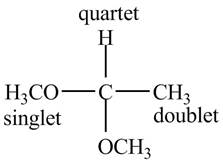
Explanation of Solution
There are three signals in the compound. One is at
Therefore, the structure of the compound corresponding to NMR data is shown below.

Figure 3
The structure of the compound having molecular formula
(d)
Interpretation:
The structure of the compound having molecular formula
Concept introduction:
Many nuclei and electrons have spin. Due to this spin magnetic moment arises. The energy of this magnetic moment depends on the orientation of the applied magnetic field. In NMR spectroscopy, every nucleus has a spin. There is an angular momentum related to the spin. The difference between its resonance frequency and that of the reference standard is known as the chemical shift of a nucleus. Tetramethylsilane (TMS) is taken as reference.
Answer to Problem 13.40AP
The structure of the compound having molecular formula
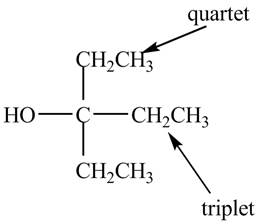
Explanation of Solution
The given spectrum is shown below.
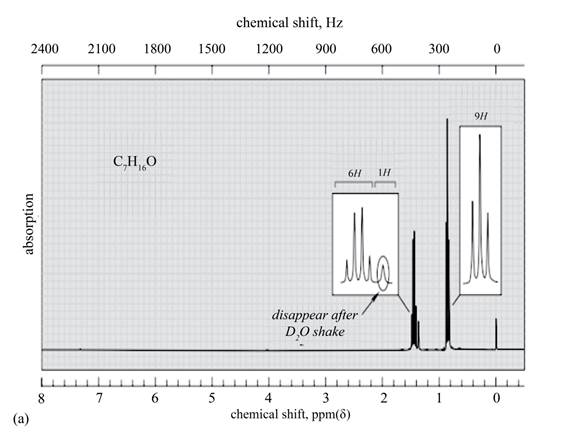
Figure 4
There are three signals in the compound. One is at
Therefore, the structure of the compound corresponding to NMR data is shown below.

Figure 5
The structure of the compound having molecular formula
(e)
Interpretation:
The structure of the compound having molecular formula
Concept introduction:
Many nuclei and electrons have spin. Due to this spin magnetic moment arises. The energy of this magnetic moment depends on the orientation of the applied magnetic field. In NMR spectroscopy, every nucleus has a spin. There is an angular momentum related to the spin. The difference between its resonance frequency and that of the reference standard is known as the chemical shift of a nucleus. Tetramethylsilane (TMS) is taken as reference.
Answer to Problem 13.40AP
The structure of the compound having molecular formula
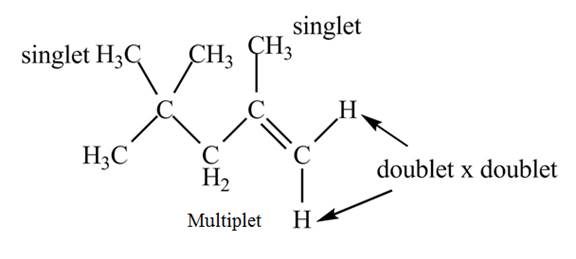
Explanation of Solution
The given spectrum is shown below.
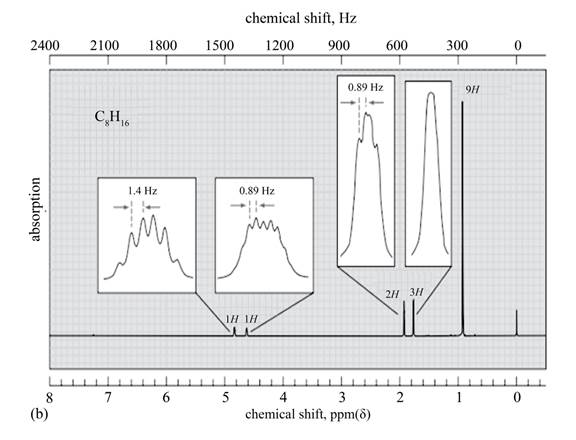
Figure 6
It is given that the
The
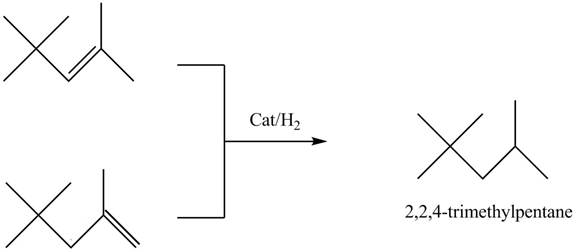
Figure 7
There are five signals in the compound. The two signal at
Therefore, the structure of the compound corresponding to NMR data is shown below.

Figure 8
The structure of the compound having molecular formula
(f)
Interpretation:
The structure of the compound having molecular formula
Concept introduction:
Many nuclei and electrons have spin. Due to this spin magnetic moment arises. The energy of this magnetic moment depends on the orientation of the applied magnetic field. In NMR spectroscopy, every nucleus has a spin. There is an angular momentum related to the spin. The difference between its resonance frequency and that of the reference standard is known as the chemical shift of a nucleus. Tetramethylsilane (TMS) is taken as reference.
Answer to Problem 13.40AP
The structure of the compound having molecular formula
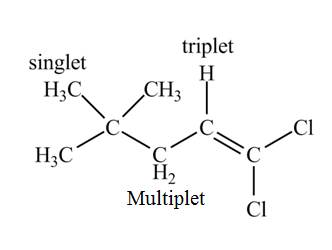
Explanation of Solution
There are three signals in the compound. The signal at
Therefore, the structure of the compound corresponds to NMR data as shown below.

Figure 9
The structure of the compound having molecular formula
(g)
Interpretation:
The structure of the compound having molecular formula
Concept introduction:
Many nuclei and electrons have spin. Due to this spin magnetic moment arises. The energy of this magnetic moment depends on the orientation of the applied magnetic field. In NMR spectroscopy, every nucleus has a spin. There is an angular momentum related to the spin. The difference between its resonance frequency and that of the reference standard is known as the chemical shift of a nucleus. Tetramethylsilane (TMS) is taken as reference.
Answer to Problem 13.40AP
The structure of the compound having molecular formula
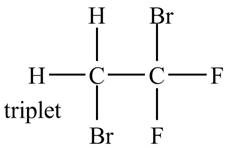
Explanation of Solution
There is only one signal in the compound for two hydrogens that means both are equivalent. The triplet signal is given by the two protons that means the splitting of the signal is done by two equivalent fluorine groups.
Therefore, the structure of the compound corresponding to NMR data is shown below.

Figure 10
The structure of the compound having molecular formula
(h)
Interpretation:
The structure of the compound having molecular formula
Concept introduction:
Many nuclei and electrons have spin. Due to this spin magnetic moment arises. The energy of this magnetic moment depends on the orientation of the applied magnetic field. In NMR spectroscopy, every nucleus has a spin. There is an angular momentum related to the spin. The difference between its resonance frequency and that of the reference standard is known as the chemical shift of a nucleus. Tetramethylsilane (TMS) is taken as reference.
Answer to Problem 13.40AP
The structure of the compound having molecular formula
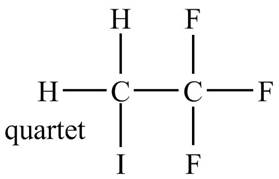
Explanation of Solution
There is only one signal in the compound for two hydrogens that means both are equivalent. The quartet signal is given by the two protons that means the splitting of the signal is done by three equivalent fluorine groups.
Therefore, the structure of the compound corresponding to NMR data is shown below.

Figure 11
The structure of the compound having molecular formula
(i)
Interpretation:
The structure of the compound having molecular formula
Concept introduction:
Many nuclei and electrons have spin. Due to this spin magnetic moment arises. The energy of this magnetic moment depends on the orientation of the applied magnetic field. In NMR spectroscopy, every nucleus has a spin. There is an angular momentum related to the spin. The difference between its resonance frequency and that of the reference standard is known as the chemical shift of a nucleus. Tetramethylsilane (TMS) is taken as reference.
Answer to Problem 13.40AP
The structure of the compound having molecular formula
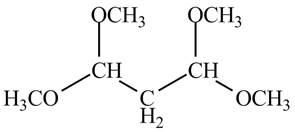
Explanation of Solution
There are three signals in the compound and total hydrogens are sixteen. The relative intergral tells about the ratio of number of hydrogen in each signal. The relative integral is
Therefore, the structure of the compound corresponding to NMR data is shown below.

Figure 12
The structure of the compound having molecular formula
(j)
Interpretation:
The structure of the compound having molecular formula
Concept introduction:
Many nuclei and electrons have spin. Due to this spin magnetic moment arises. The energy of this magnetic moment depends on the orientation of the applied magnetic field. In NMR spectroscopy, every nucleus has a spin. There is an angular momentum related to the spin. The difference between its resonance frequency and that of the reference standard is known as the chemical shift of a nucleus. Tetramethylsilane (TMS) is taken as reference.
Answer to Problem 13.40AP
The structure of the compound having molecular formula
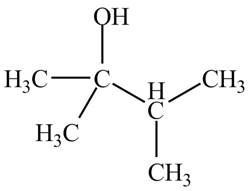
Explanation of Solution
There are three signals in the compound and total hydrogens are fourteen. The doublet signal at
The signal at
Therefore, the structure of the compound corresponding to NMR data is shown below.
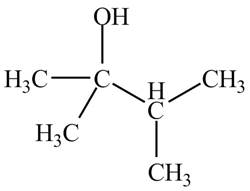
Figure 13
The structure of the compound having molecular formula
Want to see more full solutions like this?
Chapter 13 Solutions
EBK ORGANIC CHEMISTRY STUDY GUIDE AND S
- Soap is made by the previous reaction *see image. The main difference between one soap and another soap isthe length (number of carbons) of the carboxylic acid. However, if a soap irritates your skin, they mostlikely used too much lye.Detergents have the same chemical structure as soaps except for the functional group. Detergentshave sulfate (R-SO4H) and phosphate (R-PO4H2) functional groups. Draw the above carboxylic acidcarbon chain but as the two variants of detergents. *see imagearrow_forwardWhat are the reactions or reagents used? *see imagearrow_forwardWhat are the reactions or reagents used? *see imagearrow_forward
- Provide the mechanism for this transformation: *see imagearrow_forwardAssign all the signals individually (please assign the red, green and blue)arrow_forwardThe two pKa values of oxalic acid are 1.25 and 3.81. Why are they not the same value? Show the protontransfer as part of your explanation. *see imagearrow_forward
- .. Give the major organic product(s) for each of the following reactions or sequences of reactions. Show ll relevant stereochemistry [3 ONLY]. A H Br 1. NaCN 2 NaOH, H₂O, heat 3. H3O+ B. CH₂COOH 19000 1. LiAlH4 THF, heat 2 H₂O* C. CH Br 1. NaCN, acetone 2 H3O+, heat D. Br 1. Mg. ether 3. H₂O+ 2 CO₂ E. CN 1. (CH) CHMgBr, ether 2 H₂O+arrow_forwardAssign this COSY spectrumarrow_forwardCan I please get help with this?arrow_forward
 Organic ChemistryChemistryISBN:9781305580350Author:William H. Brown, Brent L. Iverson, Eric Anslyn, Christopher S. FootePublisher:Cengage Learning
Organic ChemistryChemistryISBN:9781305580350Author:William H. Brown, Brent L. Iverson, Eric Anslyn, Christopher S. FootePublisher:Cengage Learning

